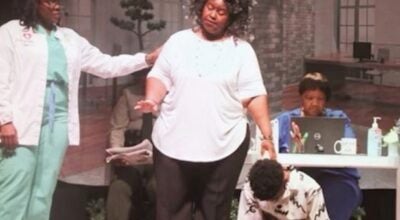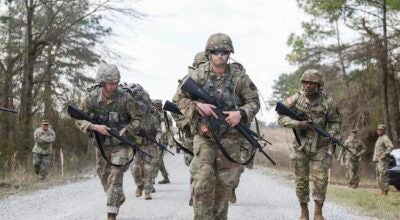Courage is not measured by the size of a man
Published 12:00 am Monday, April 27, 1998
Rebecca Burk / L’Observateur / April 27, 1998
LUTCHER – With the birth of their first child 10 years ago, Zip and Sally Zimmer had no idea they would religiously carry a medicine bag with them to the ball games, dance recitals and school functions in which their children participate.
But they do, and Sally said it’s no big deal. It’s second nature. It’s a part oftheir life.
Zip and Sally’s first child, Robert, was born in 1989 with cystic fibrosis.
“When Robert was born he was rated a nine,” Sally said. “At 36 hours theyasked me if I had cystic fibrosis in my family. I told them that I didn’t.But they checked him, and the Oschner team came to get him.”After answering, Sally remembered that her cousin died of cystic fibrosis.
What gave doctors a clue that Robert might have the disease was not the fact that Sally had it in her family, it was that he hadn’t had a bowel movement yet. “CF babies usually don’t,” Sally said.Sally said that when she went to see baby Robert at Oschner he had needles and tubes all over his tiny body.
“I just told them, ‘Look. You need to take all of these needles out of him,'”she said. “The doctor said that sometimes mother knows best and theytook them out.”After Oschner, they were referred to Tulane Medical Center for treatment.
“I can happily say that that’s the only time he has ever been in the hospital,” Sally said.
At the time of Robert’s birth there was no method to determine if someone is a carrier of the CF gene.
“I had no inkling that I was a carrier of this disease when I got pregnant with Robert,” Sally said. “When Robert was born there was no way ofidentifying whether or not you are a carrier.”But now, after many years of research, doctors can determine through tests who carries the CF gene and who doesn’t. And that’s only one of thethings this research has accomplished in finding a cure for the disease.
Treatment medicines to extend the lives of people with CF have been created. Fifteen years ago the life expectancy of someone with the diseasewas 18. Now it’s 30.Genetic researchers are very close to finding a cure.
The research done over the past 10 years was mostly funded by fund- raisers of the Cystic Fibrosis Foundation. One of those fund-raisers drawshundreds of locals to Lutcher Park in St. James Parish each year.It’s called Great Strides, a walk-a-thon to raise money to find a cure for cystic fibrosis.
The walk began nationally 10 years ago, and with Robert being only a few months old and testing positive with the disease Sally wanted to do everything she could to make sure a cure is found.
She formed the St. James Cystic Fibrosis Foundation, and along with theNational Cystic Fibrosis Foundation coordinated the first walk to raise money in the River Parishes. She is also president of the St. James CysticFibrosis Foundation and has been for 10 years.
The first walk in 1989 was a success, as well as the ones following, Sally said. They raised $3,200 the first year and got a little more each year,raising $15,000 in last year’s walk.
“Each year the goal is to get $1 more than last year,” Zimmer said.
About two years after the first walk, Sally got pregnant again. There wasonly a one in four chance that her second child would have the disease.
She had the option of getting tested to find out if her baby had cystic fibrosis, but she didn’t want to know.
“There was no way I was going to abort the pregnancy,” she said. “Iwanted to stay positive. I kept saying God’s not going to do this to me twotimes in a row.”When Mya was born, everything seemed alright in the beginning.
“She was perfectly fine,” Sally said. “They brought her into the room andshe had a bowel movement and you would have thought she had a million dollars.”But they tested Mya anyway, and after three readings she tested positive.
At 4 months old she developed pneumonia, Sally said. But she recuperatedand was able to go home.
“Both of my kids are fighters,” Sally said. “They fight when they aresick.”Now at ages 9 and 7, Robert and Mya act as normal as any children and are especially active.
They excel in all of their extra-curricular activities and maintain A averages in school. Sally said they each have gotten perfect attendancecertificates.
Robert was recently chosen an all-star baseball and basketball player in the St. James Parish league. And Mya recently won a solo dancecompetition in Alabama in the 5-12 years old age group.
“She was up against about 120 others,” Sally said proudly.
“They are very active and have always been,” Sally added. “The moreexercise they have the better off they are because their lungs are working.
Robert has been playing baseball and sports since he was 5. I keep thembusy. The doctors say that’s good because they don’t have time to knowthey are sick.”And at all of the activities they participate in, Sally is there with the medicine bag in tow, just in case.
“Raising a CF child is totally different than raising a normal child,” Sally said. “I always carry a medicine bag wherever I go.”The medicine bag contains the children’s medicine enzymes that help with digestion because they are most affected by the intestinal disorders of CF than with the lung trouble, although both kids have asthma. But Sally saidthat’s normal among people with CF.
Robert has been on the enzyme all of his life, while Mya started taking it when she was 5.
“They increase the enzyme as they feel the need,” Sally said.
In addition to keeping up with her kids and all of their activities, Sally also keeps herself busy. She not only is the president and founder of theSt. James Cystic Fibrosis Foundation, but is also the PTO president atPaulina Elementary, where the children attend, and a physical education teacher at LaPlace Elementary. “I don’t want to stop,” Sally said. “Itwould give me too much time to think.”Because of all of the activities they are in and the great care they have, their doctor told Sally that Robert and Mya were both prime candidates for gene transplants. But in searching for a cure for the disease, the thingresearchers are baffled about is finding which gene is the bad one, Sally said.
“The only cure is for them to find the bad gene and replace it, but that’s what they are looking for to find a cure,” Sally said.
And that’s why raising money for the walk-a-thon is so important to Sally and her family.
“We’re very fortunate because they are very close to identifying the gene,” Sally said.
But that doesn’t make it any less scary for the Zimmers and their children.
Sally said one night she was at a meeting and Mya was home with her dad watching television.
They were watching 20/20 and a segment came on about cystic fibrosis.
Zip tried to change it, but Mya insisted upon watching it.
It was about a girl who had the disease and she was supposed to be in her brother’s wedding. She got very sick before the wedding and almostcouldn’t attend, but she got well just in time.
Doctors knew her illness was getting worse and worse so they planned a lung transplant for the girl, in which her mother gladly offered one of her lungs.
The girl got the lung, but died a few weeks later.
Mya, shaken by the program, asked her dad, “Why didn’t God make me with nothing wrong with me?” When Sally got home that night, Mya was already asleep, but her husband warned her about the show, knowing that Mya would question Sally about it in the morning.
Sally said the next morning as she was in the kitchen making pancakes for breakfast, Mya came in and told her about the show. She asked her if shegot really sick and was going to die would Mom give her one of her lungs? “I told her that she would get one from me and one from her dad,” Sally said with tears in her eyes.
Sally said Mya went to school that day and told her teachers about the program. Mya saw the worry and sadness on their faces and told them,”Don’t worry. My mom said she and my dad would give me their lungs.””I know I have a hard road ahead of me because her questions are going to get worse,” Sally said.
The two children have a unique relationship. “They help each other out alot with their medicine and have a bond that’s unique,” Sally said.
And taking their medicine is something they do so often they don’t even think about it anymore.
“It’s a part of their life, just like brushing their teeth,” Sally said.
Although the children are active and happy just like any other child their age, raising money to find a cure is the most important thing on the agenda for Sally and her family.
The next walk is May 16 at Lutcher Park. Call Sally at 869-8964 for moreinformation and to find out how to assist researchers in finding a cure for this deadly disease.
Photo: THE ZIMMERS, from left, Mya, Sally, Robert and Zip.
Return To News Stories




